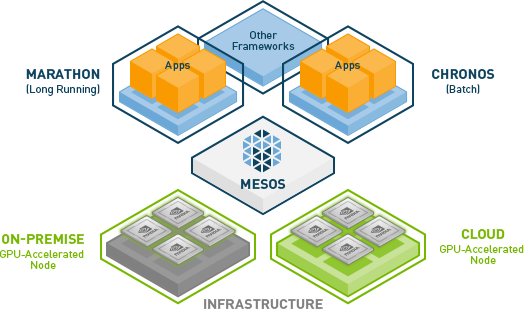Article Source
- Title: Apache Mesos and GPUs
Apache Mesos and GPUs

Manage Accelerated Applications at Data Center Scale
The Tesla Accelerated Computing Platform now supports Apache Mesos, a popular distributed resource manager for scheduling applications across the datacenter.
Tesla GPU accelerators are native, first-class resources in Apache Mesos and the core frameworks, i.e. Marathon and Chronos. This enables a diverse set of applications to share fine-grained GPU resources while running in parallel on a common infrastructure.

Higher Application Throughput
Dynamic partitioning of GPUs ensure efficient allocation of resources per application. By delivering finer-grained GPU resources to applications, Mesos delivers higher resource utilization and faster application performance.
Operational Simplicity
GPU-accelerated applications can now be deployed on a common cluster, sharing resources with other applications, both on premise and in cloud infrastructures. This streamlines the data center operations significantly by removing the overhead of maintaining multiple, independent clusters.
High Availability
GPU-accelerated applications now benefit from built-in fault tolerance and self-healing features within Mesos, improving the overall reliability of the applications.
Popular Marathon and Chronos frameworks deliver key benefits to GPU-accelerated applications:
- Marathon support for long-running jobs with REST APIs for starting, stopping, and scaling applications
- Chronos support for cron-based batch jobs
- Built-in high availability with the option to run any number of scheduler instances
- Service discovery, load-balancing, and health checks
- Web UI
- Native Docker support
Deep Learning on GPU Clusters
In this video from the Nvidia Theater at SC14, Bryan Catanzaro from Baidu presents: Deep Learning on GPU Clusters.
Abstract
Deep neural networks have recently emerged as an important tool for difficult AI problems, and have found success in many fields ranging from computer vision to speech recognition. Training deep neural networks is computationally intensive, and so practical application of these networks requires careful attention to parallelism. GPUs have been instrumental in the success of deep neural networks, because they significantly reduce the cost of network training, which then has allowed many researchers to train better networks. In this talk, I will discuss how we were able to duplicate results from a 1000 node cluster using only 3 nodes, each with 4 GPUs.